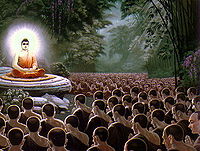|
Magha Puja is the second-most sacred of three annual Buddhist holidays in Thailand. Magha Puja (มาฆบูชา pronounced somewhat like mahk-ah boo-cha) takes place at the time when the full moon comes into proximity with the Magha star cluster in Indian astrology; the old name for this month is Magha).
It commemorates four miracles: 1. It was the time of the full moon in the star Magha. 2. 1250 disciples of the Buddha, all saints, assembled. 3. They [spontaneously] met at Veluvana Temple without prior arrangement. 4. They all had entered the Sangha by the simple command of the Buddha, “Ehi bhikkhu”. (Wells, K. 1960. Thai Buddhism: Its Rites and Activities. Bangkok: The Christian Bookstore, pp. 78-79). At the assembly, the Lord Buddha gave the Patimokkha to the disciples and prophesied he would die in three months (another tradition says this assembly happened much earlier in the life of the Buddha). The Patimokkha are the 227 binding rules which govern the lives of monks. These rules are recited in a solemn ceremony by all monks twice a month, but the original dissemination of the rules is celebrated in the Magha Puja ceremony using a recitation written by H.M. King Rama IV entitled the “Ovada Patimokkhadi Patha”. This recitation underlines the importance of three gathas: the non-doing of evil, the full performance of what is wholesome, the total purification of the mind.” (Swearer, D. 1995. The Buddhist World of Southeast Asia second edition. Chiang Mai: Silkworm Books, p. 38) Magha Puja is very much focused on the Sangha and the spiritual life of monks. This year, 2559 BE, Magha Puja falls on February 22, the full moon of the third lunar month (by Central Thai reckoning). It is a national holiday. All government offices and educational institutions will be closed. Festivities in temples in the central part of the country will probably be at night, but in the morning in Chiang Mai and the north. About these things there is widespread agreement. But just which of the “Triple Gems” is being emphasized on this occasion? There are three major holidays. Don Swearer declared in 1990 that Magha Puja represents one of the “Triple Gems of Theravada Buddhism: the Buddha, the Dhamma and the Sangha.” He lists the 3 holidays in order: Visakha Puja (birth, enlightenment and death of the Buddha), Asalha Puja (the Buddha’s first discourse of the Dhamma) and Magha Puja (where the Sangha is formally organized). On the other hand, Ken Wells, reporting on his research from the 1930s lists only 2 main Buddhist holidays, Visakha and Magha Puja and says that Magha is sometimes called “The Buddhist All Saints Day and Dharma Day….” (ibid., p. 79). In other words, it is primarily about Dharma as well as enlightened ones. Wells makes no mention of Asalha Puja Day because it was mandated much later by the central government at the time of the celebration of the 2500th anniversary of Buddhism, to round-out the three festivals, giving each of the Gems its due. Magha Puja Day was initiated by King Mongkut (Rama IV) and formally set as a national holiday by his son, King Chulalongkorn (Rama V). As for the “saints” who gathered, they were all arahants. Most scholars writing for Western readers use the word “saints” for arahants, asThe Bangkok Times first did on February 26, 1937. By the end of the Buddha’s earthly mission there were many monks and disciples, but fewer arahants. Arahants have had the break-through to an enlightened, ego-less state. They have seen the nature of the universe and may have glimpsed their past lives. Being an arahant is a perfected state that few achieve or attempt to achieve. But Magha Puja is designed to keep this goal in mind, as well as to venerate all who have taken the strict vows of ordination. Finally, we see that the agricultural connection between Magha Puja and the rice harvest is diminishing. The association is not only no longer remembered, the actual agricultural calendar has shifted. For a long time the rice harvest was in January and so Magha Pujacame at the end of it as a sort of thanksgiving. Now with two rice crops a year, planting and harvesting are out of synchronization with the religious calendar. In modern times, Magha Puja may never have been a harvest thanksgiving event per se, but Buddhism and all world religions sustained the age-old awareness of humanity’s spiritual roots in the soil. Shifts in culture need to be responded to by religious entities if they are to stay relevant. No one was more aware of this than King Mongkut, when he re-focused Magha Puja away from its pre-modern blur. It remains to be seen, perhaps a couple of generations from now, how the disconnection of Buddhist festivals from village cycles will impact piety and participation.
0 Comments
Leave a Reply. |
AuthorRev. Dr. Kenneth Dobson posts his weekly reflections on this blog. Archives
March 2024
Categories |
| Ken Dobson's Queer Ruminations from Thailand |
|

 RSS Feed
RSS Feed
